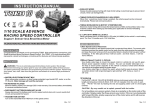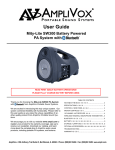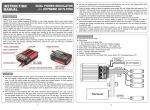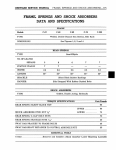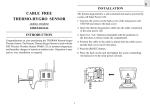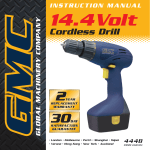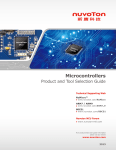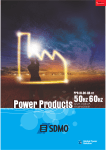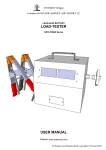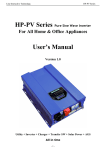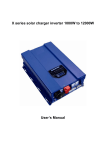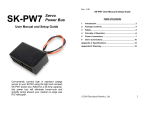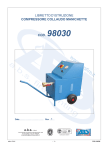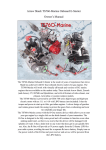Download SC120 manual - Vicious Teknology
Transcript
INSTRUCTION MANUAL For best results clean the bottom of the speed control and chassis. Peel off the cover on one side of the doubled-sided tape, and stick to the bottom of the speed control. Peel off other side and stick the ESC to the chassis. You may use the mounting plate(included) to fix the ESC to the chassis. 53mm 45.4mm 120 DAYS 14 +Yr BRUSHLESS ESC FOR SHORT COURSE Use a small piece of double-sided tape on the ON/OFF switch. INTRODUCTION Congratulations and thank you for purchasing TORO, Short Course(SC), high performance brushless motor electronic speed control. The TORO SC,brushless ESC represents a latest technologies, providing all the features and robust design qualities. SAFETY NOTE WARNING: This is an extremely powerful brushless motor system. We strongly recommend removing your pinion gear for your own safety and the safety of those around you before performing calibration and programming functions with this system. Please keep your hands, hair, cloth, clear from the gear train and wheels of an armed high performance system. WATER & ELECTRONICS DON'T MIX! Never allow water, moisture, or other foreign materials to get inside ESC, motor, or on the PC Boards. Water damage will void the warranty! NO REVERSE VOLTAGE! Reverse battery polarity can damage ESC & void warranty. Disconnect battery immediately if a reverse connection occurs. DISCONNECT BATTERIES WHEN NOT IN USE Always disconnect the battery pack from the speed control when not in use to avoid short circuits and possible fire hazard. 2 - 4 LI-PO CELLS ONLY Never use fewer than 2 or more than 4 LIPO cells in the vehicle's main battery pack. The TORO SC handles up to 4S LIPO input (16.8 Volts MAX). TRANSMITTER ON FIRST Turn on the transmitter first THEN turn on the speed control. INSULATE WIRES Always insulate exposed wiring with heat shrink tubing or electrical tape to prevent short circuits, which can damage ESC. SHORT COURSE OR SMALLER The TORO SC is intended for4x4 Short Course or Smaller. BEFORE YOU BEGIN 1)Plan Speed Control Placement Choose a location for the speed control that is protected from debris. To prevent radio interference place the speed control as far away from the radio receiver as possible and keep the power wires as short as possible. 1/8 Ver. 1.1 2) Soldering TIPS & TRICKS: Place the speed control upright and use double sided tape to secure it to the bench. Doing so provides a stable work area and allows easy access to the solder posts. Attaching Wires to the Speed Control: Red wires are usually used to connect the speed control to the positive battery terminal. Black wire is typically used for the battery negative terminal. Inspect the housing on the speed control next to each post or refer to the diagrams to determine which color wire to attach to each post. Strip back the insulation of the wire by about 2.4mm to 3.2mm (3/32" to 1/8") and "pre-tin" the wire by heating the end and applying solder until it is thoroughly covered. CAUTION: Be very careful not to splash yourself with hot solder. Place the tip of the iron in the notch on top of the post and apply a small amount of solder to the post. When the solder has flowed, remove the soldering iron, wipe the tip clean and apply a small amount of fresh solder to it. Pre-Heat both the wire and the post. Hold the wire so the tinned end is in contact with the notch of the post. Now touch the iron tip to the wire and the post. Wait about 4 seconds for the solder to flow, and then remove the iron while still holding the wire. You may let go of the wire after a second or two when the solder sets. Same techniques described in the preceding section may be used to solder the wires to the battery or to battery connectors. IMPORTANT: Take precautions if removing factory battery connectors. Connecting the battery backwards will cause damage, and will void warranty. When soldering connectors to a battery pack, cut only one wire of the battery pack at a time to ensure that the exposed wires cannot short together. HINT: If you are using connectors for both the battery and the motor, make sure that they are not the same or that you have a male and a female attached to the speed control wires. That way, you cannot accidentally connect the battery to the motor wires or vice versa. Make sure that the connector ends will be mated together correctly, male to female, and that the wire colors match red to red and black to black. 2/8 Ver. 1.1 Prolonged/excessive heating of solder post (motor or ESC) will damage PCB. Note: Make sure no wire strands have strayed to an adjacent solder post, this will result in short-circuiting & severe ESC damage, which will void the warranty. CONNECTIONS Brushless Motor Wiring Connect the blue, yellow and orange motor wires to the motor. There is no polarity on the three ESC-to-motor wires, so do not worry about how you connect them initially. You may find it necessary to swap two wires if the motor runs in reverse. How to Calibrate ESC ESC switch OFF. Turn on the Transmitter. Hold full throttle on your transmitter and turn the ESC's switch ON. Keep holding full throttle on the transmitter. The ESC will flashes LED and ring the initialization tones. Wait 2 seconds Green LED blinks rapidly and the motor will rings 1 second indicating full throttle measured. Red LED blinks whiles beeping, indicating it's time to push full brake. Move throttle trigger to full brake and wait few seconds, the ESC will blink red LED and rings 1 second indicating full brake measure. To Batt - To Batt + Switch On/Off Status LED(Multi Color) Forward: Green Reverse: Red Stand By: Orange Fan To Receiver Channel 2 (Throttle) Orange LED blinks whiles beeping, indicating it's time for neutral. Relax trigger to neutral (center). The ESC flash the orange LED rapidly to accept the neutral position. ESC rings 1 second indicating neutral position measure. After calibration ESC will rings 1 second indicating that it is armed. From this point on, when you connect batteries and turn on the switch, the ESC will give the initialization tone and flash, and the arming tone will ring second or two later. If the ESC is programmed for the Auto-Lipo setting, it will beep the number of cells in you Lipo pack between the initialization tones and the arming tones. After the arming tone plays, the ESC will ACTIVE and will respond to the throttle application. Power Capacitor ESC PROGRAMMING Heat Sink Fan / Program Connector 1)Programming Card(Optional Part) Programming Card allows you to modify the most commonly used settings in your TORO SC controller all at the touch of a single button. No computer needed. Simply disconnect the Fan lead from ESC and connect program lead form program card to ESC’s program connector. Power the programming card as described below. Press and release button to move between settings. Press and hold button to change the value for that setting. All the settings will show on the programming card at once. Can't get any easier! Battery ESC/TRANSMITER CALIBRATION IMPORTANT NOTE: Calibration is necessary for the first use of the ESC, or whenever used with a new/different transmitter. For users with a Futaba Transmitter, you must reverse the throttle channel signal on your transmitter. Please refer to your Futaba instructions. Individual transmitter's signals for full throttle, full brake and neutral vary. You must calibrate your ESC so that it will operate more effectively with you transmitter. 3/8 Ver. 1.1 Fan / Program Connector To Receiver Channel 2 (Throttle) Program Lead (Servo wire) 4/8 Ver. 1.1 2)Manual Programming Manual Programming TORO SC is as simple as answering a few questions. The TORO SC asks questing by beeping a setting number, followed by the possible setting values. There are nine settings that can be programmed in the TORO SC. Programmable Features Question (Setting) 1)Reverse Lockout(D)* 2)Normal(D)* Motor Direction 1) Normal(D)* This is default motor rotation direction 2)Reverse Opposite default motor rotation direction 2)50%(D)* Note: Factory Defaults are indicated by asterisk (D)* You must answer "yes" or "no" to the setting values as they are presented by TORO SC. When you enter programming mode the ESC will emit a sequence of beeps and LED flashes that tell you which programming step you are in. There are two parts to the beep sequence. The first set of beeps indicates the 'Setting Number (Question), e.g. Brake/Reverse Type, and the second set of beeps indicates a Setting Value, e.g. Reverse Lockout. Answering "No" to a Setting value will cause the ESC to ask for the next value in that section. After a "Yes" answer is accepted, the ESC knows you aren't interested in any other option in that section, so it skips to the first option in the next section. 2)50%(D)* Note: If you answer "no" to all Setting Values for a particular Setting Number, the ESC will keep whatever value had been previously programmed. Only by answering "Yes" to a Setting Value will the ESC store/change that value. 5)Disable(D)* 1)Disable(D)* How to Enter Programming Mode Plug Battery into the TORO SC Hold full throttle on your transmitter Turn the ESC switch ON TORO SC flashes LED and rings once Wait few seconds. TORO SC flashes LED and rings 1 second indicating that it is ready for CALIBRATION mode Continue to hold full throttle TORO SC flashes LED while beeping Wait another few seconds TORO SC flashes LED and rings 1 second TORO SC flashes LED while beeping indication that you are in PROGRAMMING mode Let trigger go neutral (Centre) 1)Large 2)Normal(D)* 3)Small 4)Very Small 5)Smallest At this point the TORO SC will be flashing/beeping the following sequence: Beep-Pause-Beep... and then repeats This indicates that you are at Question 1 and it is asking to accept/reject value 1. 2)Auto-Lipo(D)* 5/8 Ver. 1.1 6/8 Ver. 1.1 When answering a question, you will need to move the trigger to yes (full throttle) position or the no (full brake) position and keep it there for about 3 seconds. When the ESC has accepted your answer it will confirm your reply by flashing the LED and emitting a beeping tone. Release the trigger allowing it to go to Neutral to confirm that you are ready for ESC to ask you next question. You are not required to continue through all nine programming options. For example, if you wish only to change the Brake/Reverse Type (Option 1) then after programming that setting you can disconnect power from the ESC and you're ready to run. Disconnecting the controller in the middle of programming simply retains the values for the remaining programming options that were previously set up. FAN REPLACEMENT The TORO SC comes with a 30mm x 30mm x 10mm 5V Brushless fan. Should the fan need replacement, simply unplug the fans power wire from the TORO SC, remove the 4 screws that secure the fan and remove the fan cover. Solution: Try moving the throttle trim one way, then the other (usually towards the throttle side is best). If your transmitter has a 50/50 and 70/30 setting for the throttle, set it for 50/50 and retry calibration. Also, if you have changed the dead band to a narrower band you may want to try going back to the "normal" setting. Problem: My vehicle acts like it has " turbo lag " (poor acceleration/punch for the first few feet or yards) Solution: Make sure you're using high quality batteries and a battery connector capable of high amp flow (40-100 amps). This behavior is very typical of a battery pack that is having difficulty providing the power your vehicle/system requires for top performance. Use copper bars to connect cells rather than welded tabs. Copper bars have a much lower resistance. Problem: My battery pack is plugged into the ESC and nothing is working Solution: Make sure the ESC's receiver plug is plugged into channel 2 on the receiver, and that it's plugged in with the correct orientation. Double check your solder connections on the battery plug, and make sure the battery is showing good voltage. SPEED CONTROL SPECIFICATION Controls, TORO SC Rev/Brk/Brk or Fwd/Fwd Motor Limits,TORO SC Input Power (Cells) PRODUCT WARRANTY Brushless KV ≤ 6000 Up to 2S(8.4Volt), ideal for 1/10 short course Brushless KV ≤ 4000 Up to 3S(12.6Volt), for 1/10 buggies and short course Brushless KV ≤ 3000 Up to 4S(16.8Volt), ideal for 1/8 buggies On Resistance,Brushless 0.0004 Ohms per phase at 25℃(77℉)Trans.Temp Continuous /Burst Current 120Amp / 760Amp Switching BEC 6V 5Amp Status LED 1 with 3 color (Red, Green & Orange) Thermal Overload Protection Yes Dimensions(LxWxH) 55x37.6x38.4mm (2.17x1.47x1.51in) Weight (Without wires) 87g (3.07oz) The TORO SC Brushless ESC is guaranteed to be free from defects in materials or workmanship for a period of 120 days from the original date of purchase (verified by dated, itemized sales receipt). Warranty does not cover incorrect installation, components worn by use, damage to case or exposed circuit boards, damage due to timing, damage from using more than 4S Li-Po cells input voltage, cross-connection of battery/motor power wires, overheating solder tabs, reverse voltage application, improper use or installation of external BEC, damage resulting from thermal overload or short-circuiting motor, damage from incorrect installation of FET servo or receiver battery pack, tampering with internal electronics, allowing water, moisture, or any other foreign material to enter ESC or get onto the PC board, incorrect installation/wiring of input plug plastic, allowing exposed wiring or solder tabs to short-circuit, or any damage caused by a crash, flooding or natural disaster. Because SKYRC has no control over the connection & use of the speed control or other related electronics, no liability may be assumed nor will be accepted for any damage resulting from the use of this product. Every SKYRC speed control & motor is thoroughly tested & cycled before leaving our facility and is, therefore, considered operational. By the act of connecting/operating speed control, user accepts all resulting liability. In no case shall our liability exceed the product's original cost. We reserve the right to modify warranty provisions without notice. This product is not intended for use by children under 14 years of age without the strict supervision of an adult. Use of this product in an uncontrolled manner may result in physical damage or injurise take extra care when operating any remote control vehicle. TROUBLE SHOOTING Problem: My TORO ESC may or may not arm, but it will not calibrate to my transmitter Solution: Most calibration issues can be solved by changing settings on the transmitter. Make sure you have both your throttle and brake endpoints (called EPA or ATV on your radio) on the throttle channel out to between 100 to 120%. Make sure if you have a Futaba or Futaba made transmitter to have the throttle channel set to the reversed position. Problem: My ESC calibrates for the full throttle and full brake positions but won't calibrate to the neutral throttle position. (Orange LED keeps flashing) SPECIFICATIONS ARE SUBJECT TO CHANGE WITHOUT NOTICE. Manufactured by SKYRC TECHNOLOGY CO., LTD. www.skyrc.com 2011 SkyRC Technology Co., Ltd. All Rights Reserved. 7504-0215-01 7/8 Ver. 1.1 8/8 Ver. 1.1




